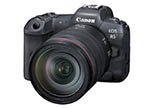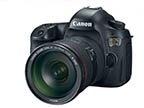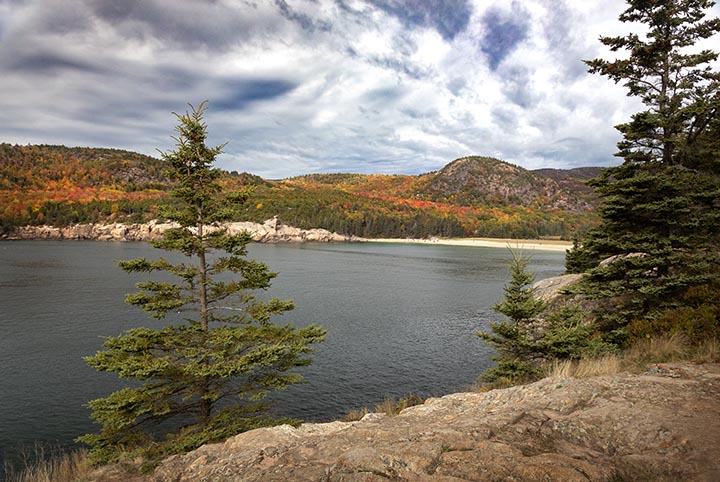Best Canon Camera For Landscape Photography
List of Top 7 Recommended Landscape Cameras
Although many Canon cameras are good enough to take great landscape photos, we'll answer the question of which is the very best choice when it comes to using a Canon camera for landscape photography.
It's good to know you have lots of choices and when you're done reading this article you'll feel less confused.
In this post you'll also learn what features are important as well as see the list of the top 7 landscape cameras. The list includes all 3 camera types: the newer Canon mirrorless format, the full frame Canon DSLRs, and the Canon crop cameras with APS-C sensors.
Many factors can be used to judge the value of any digital camera, but there are three camera features that are the most important for you to know about for shooting landscapes. We'll look at all the desirable features next, or you can jump straight to the summary of top 7 recommended landscape cameras.
Vital Landscape Camera Features
Before you look at specific cameras to use for photographing landscapes it's important you know what to look for.
MEGAPIXEL COUNT. This is the most important feature to pay attention to when it comes to shooting landscapes. The more megapixels on your camera sensor the more details you get in your final photograph.
For landscape photography, you don't need a camera super fast focusing, or a high frame rate for shooting action photos in a super fast sequence. You want detailed image files that can be printed to a large wall size without loss of quality.
WEATHER SEALING. Sometimes the best landscape photos involve shooting in adverse conditions. That includes inclement weather like rain, snow or blowing dust particles in the wind. If your landscape cameras has weather sealing, you can shoot under adverse conditions without damaging your equipment.
LENS CHOICES. Perhaps just as important, you'll want to have the opportunity of choosing just the right lens for shooting the best landscape photos. No matter what type of Canon you choose you'll have no issue finding the right lens to use due to Canon's extensive lens lineup in all formats.
Additionally, there are other features that may or may not be as important to you, depending on the particular type of landscapes you will be photographing and your personal preferences. Okay, dive into the other features to look for.
Additional Desirable Landscape Camera Features
DYNAMIC RANGE. Landscape photography may involve shooting scenes that have a large variation in the levels of light in different areas of your scene. In other words, there may a big range in the dark areas and very bright areas of your subject. Cameras that have a better ability of capturing that dynamic range will require less complicated technique when shooting as well as reduce any needed post-capture software editing of contrasty scenes.
HIGH ISO PERFORMANCE. Most landscapes can be shot with a low ISO sensitivity setting on your camera to get the maximum image quality. Astrophotography sometimes requires you to set your camera's ISO to a high number in order to get a good exposure under such dark landscape photography conditions.
High ISO settings can lead to digital noise and reduced sharpness, particularly when the individual pixels on your camera's sensor are so tiny. Generally speaking, cameras with larger individual pixels produce less high ISO noise. Also generally speaking, full frame sensor cameras have larger individual pixels because they have a much larger surface area.
FOCUS MAGNIFICATION. Very useful when precise focusing is needed for perfect sharpness of specific parts of your landscape photo. You have the ability to zoom in using your LCD screen to fine tune the focusing accuracy.
If you're landscape photography includes close ups, as in macro photography, pinpoint focusing accuracy is a must because of the extreme shallow depth of field.
LIVE VIEW. Mirrorless cameras have the advantage of seeing the brightness of the image before it's actually taken. This is very valuable when shooting landscapes under dim conditions. This can be referred to as WYSIWYG. Pronounced wizzy-wig. What You See Is What You Get.
You can also rely on using the camera's histogram feature to judge the exposure of your landscape shots, in addition to using the LCD or electronic viewfinder with mirrorless cameras.
ARTICULATING LCD SCREEN. Although not needed for the majority of landscape photos you take, you may want to shoot some of your images from either high or low vantage points. Shooting at ground level or from an above your head perspective often make your landscapes more interesting.
A fully rotating screen enables you to see your composition as you frame it in by using the LCD aimed to the best angle.
IMAGE STABILIZATION. Most serious landscape shooters use a tripod for several reasons, the most important being to insure to get a razor sharp rendition of the beautiful scene in front of you.
If you're like me, you don't mind taking your time, and you don't mind toting along with a lightweight tripod. If that's you too, then image stabilization for your camera or lens is irrelevant. In addition to image stabilization technology built into most lenses, some cameras now come with IBIS. That's In Body Image Stabilization.
The current image stabilization technology for enabling getting sharp photos while using slow shutter speeds is remarkable. You may want to travel as light as possible when your doing your landscape photography and leave your tripod at home.
While none of these features are mandatory for shooting landscapes with your Canon camera, you'll want to decide which ones matter to you and which ones aren't as important.
What Canon Should You Use For Shooting Landscapes
Although the following list of winning cameras for shooting landscapes is numbered, the list is not in any preferred order. We start with two cameras that have the smaller APS-C crop sensor cameras.
1. Canon 90D DSLR
 90D
90DThis was likely Canon's last and best APS-C sized DSLR designed for serious amateur photographers Canon will ever make. My apologies to the SL3 and t8i. The 33 MP sensor combined with the Digic 8 processor will give you a lot of fine detail in your photographs.
The 90D is the choice of a camera for you if you want a mid-sized DSLR with plenty of pixels and an optical viewfinder. When shooting landscapes with the 90D you'll want to keep your ISO setting low for maximum clean image quality.
The Canon 90D is compatible with all EF and EF-S lenses.
2. Canon EOS R7 Mirrorless
 EOS R7
EOS R7This is another APS-C crop sized sensor camera, but it's a mirrorless camera. If a compact design is a high priority, the EOS R7 is the pick for your landscape capable camera. With the same 32.5 number of megapixels as the 90D, this is the choice for the serious amateur photographer who wants a mirrorless interchangeable lens camera (milc).
The R7 gives you WYSIWYG, a live view of how the scene in front of you will render with its current camera settings. Ann added bonus is that the EOS R7 has up to 6 stops of in body image stabilization.
The EOS R7 costs a few hundred dollars more than the 90D and is compatible with the newly released RF lenses as well as any of the Canon EF and EF-S lenses with the EOS R adapter.
 Without the mirror and prism the R7 weighs about 13% less.
Without the mirror and prism the R7 weighs about 13% less.The EOS R7 is shorter and narrower than the 90D.
3. Canon EOS R Mirrorless
 EOS R
EOS RThe Canon EOS R was Canons first camera to use the newer RF lens mount and also the first full frame Canon mirrorless camera. It's a very affordable landscape camera with plenty of pixels. The EOS R uses a full-sized LP-E6N battery for extended shooting time.
The EOS R sensor has 30 million large 5.36µm pixels for the best image quality. It was the first Canon mirrorless camera I bought after 20 years of using various Canon DSLR format cameras.
The Canon EOS R is recommended for Canon shooters who want high image quality and some solid additional capabilities at a reasonable price. That's why I chose the Canon R. Here's my post on the Canon EOS R camera.
4. Canon EOS RP Mirrorless
 EOS RP
EOS RPThis is one of two budget picks for those that seek a smaller investment for a Canon landscape camera. This is the cheapest way to get a full frame mirrorless interchangeable lens camera.
Photo enthusiasts commonly ask if the Canon EOS RP is good for landscape photography. Canon has added several more full frame mirrorless cameras, so the question is if the EOS R is still any good?
The answer is yes. Just because Canon has added several new models since the RP was introduced in 2019, that doesn't lower it's sophistication at such a super entry level price for beginners.
The Canon EOS RP is very compact and light. It doesn't have quite as many pixels, 26 MP, but that's only 13% less than the original Canon EOS R. The EOS RP also uses a smaller, space-saving battery, so you can't shoot as long without a recharge as the slightly larger EOS R.
5. Canon EOS R5 Mirrorless
 EOS R5
EOS R5The Canon R5 is a great choice for serious amateurs and professional landscape photographers looking for a quality full-frame, high-resolution mirrorless camera. The biggest benefit of choosing this camera for landscape photography is the full sized 45 MP sensor.
This is a serious camera and has an accompanying serious price tag.
Additionally, the image stabilization is remarkable, giving you 6 to 8 stops of steadiness, depending on which lens you pair it with. The video below from Canon explains it well.
Bottom line with powerful image stabilization is that you can shoot static subjects like landscapes at incredibly slow shutter speeds and have them be razor sharp without using a tripod. If you happen to have a fast moving animal ro swiftly flying bird enter your frame the R5 12fps with the mechanical shutter, or 20fps with the electronic shutter.
6. Canon 5D Mark III DSLR
 5D Mark III
5D Mark IIIThe Canon 5D Mark III is an unusual choice to make the list for landscape photography, but I'll tell you why. This is the recommendation for a solid landscape camera for those photographers who don't want to spend much at all, are not apposed to buying a pre-owned camera, and still want a full frame DSLR for shooting landscapes.
I've been shooting landscapes for almost a decade with the 5D Mark III. There's a 24 x 30 inch print from Yosemite hanging on the wall behind me as I write this post.
The 5D Mark IV has a better pixel count, 30 MP versus 22 MP, but will cost you a bit more more. It all depends on how much you are willing to invest. You can use any of the extensive lineup of Canon EF lenses with both the 5D Mark III and Mark IV cameras.
The 5D Mark III is remarkably affordable for such a capable landscape camera. Check out KEH. It's where I buy my used gear.
7. Canon 5DS DSLR
 5DS
5DSWhen it was released it had the highest resolution sensor in the entire Canon EOS lineup of all time, a full frame 50.6 MP beast. That gives you a super large image file full of minute details for a very reasonable price.
Landscape photographers seeking a camera with a high resolution pixel-packed sensor should consider the Canon 5DS. That many pixels gives you the opportunity to print huge prints or crop a significant part of the image and still have plenty of quality remaining.
The 5DS takes any of the EF lenses.
As an Amazon affiliate Canon Camera Geek receives a small commission from qualifying purchases, at NO added cost to you.
Summary Table of Best Canon Camera For Landscape Photography
| CANON CAMERA | SENSOR SIZE | POSITIVES | NEGATIVES |
| Canon 90D | 32 MP Crop |
Affordable. Smaller + lighter than full frame DSLRs. Has a HUGE selection of compatible EF and EF-S lenses available. | Smaller sensor can mean more noise at high ISO. No IBIS. |
| Canon EOS R7 | 32 MP Crop |
Mirrorless technology. WYSIWYG. Advanced focusing. IBIS stabilization. | Smaller sensor means more noise at high ISO |
| Canon EOS R | 30MP Full |
Affordable-excellent value for the price. | No IBIS. Slow frames per second. |
| Canon EOS RP | 26 MP Full |
Very affordable full frame | Lower pixel count. Small battery. No IBIS |
| Canon EOS R5 | 45 MP Full |
Professional level camera. Also great for sports, action, portraits, and architecture IBIS | Expensive |
| Canon 5D Mark III | 22 MP Full |
Super Cheap, if you buy a used copy. | Low pixel count on sensor. Slightly outdated technology. No IBIS. |
| Canon 5DS | 50 MP Full |
Super detailed image quality. Relatively affordable. | Individual pixels are relatively small. No IBIS |
Lens Choice for Your Landscape Camera
As mentioned, lens choice is critical with landscape photography. Most posts giving advice on landscape lenses will only recommend wide angle lenses for landscapes.
While wide angle lenses are indeed good for shooting wide inclusive views of picturesque natural scenes, don't exclude normal and telephoto focal lengths. Sometimes the narrower views give you some fascinating images too. See the example below.
Remember as well that your skill in composing your photograph in a visually appealing way, along with choosing a time when the lighting is most interesting, play a vital role in the success of your landscape photography.
Where To Buy A Good Canon Landscape Camera
You have many choices when it comes to buying your winning choice of a Canon camera that you're going to shoot landscapes with.
Once I know what factors are most important, I narrow down my list of potentials for a specific piece of gear to a few choices. No matter where I buy, I then read the reviews on Amazon to find out the experiences other photographers have had with that equipment.
For most of the popular items, I'll just use Amazon. For more unusual camera accessories I use BHPhoto/Vide or Adorama. When I'm buying used I first check in with KEH.
I hope this post was informative for you. Have a blast. Shoot your Canon.
As an Amazon affiliate Canon Camera Geek receives a small commission from qualifying purchases, at NO added cost to you.


Bruce Lovelace is the publisher of Canon Camera Geek. Read more about him on the About Page. He also publishes how to articles and camera gear reviews at the Photography Tips website.
View some of Bruce's photos on Instagram and Flickr. Join the tribe of followers on YouTube. Bruce also runs photo workshops and provides 1 on 1 digital photography coaching.
Recent Articles
-
Free Download of Stunning Amaryllis Photo. Free Photo of Amaryllis
May 26, 25 06:57 AM
Yours to copy and enjoy. This Free Download of Amaryllis Photo -
Canon 80D FAQ
May 03, 25 04:36 PM
Frequently Asked Questions About The Canon 80D -
Canon EOS m50 error 20 message
Apr 27, 25 09:35 AM
I have a canon eos m50 dslr and my lenses keep giving me an error message error 20 but I don’t know where to take a camera to get repaired anymore? Hi -
My Review of The 10 Best Canon R6 Mark II Features That Impressed Me
Apr 12, 25 08:51 AM
Beyond the Pixel: Discover the Game-Changing Features That Make the Canon R6 Mark II a Must Have Camera -
Canon RF 24-105 Lens Comparison. Guide To Which One Is Right For You
Apr 07, 25 12:47 PM
Which is the best of the 3 versions of the Canon RF 24-105mm Lens for Canon mirrorless cameras? What's The 24-105 Lens Good For
This page may contain affiliate links that pay me a small commission. There is no cost to you. Review the affiliate statement at the very bottom of this page if you want more information.














